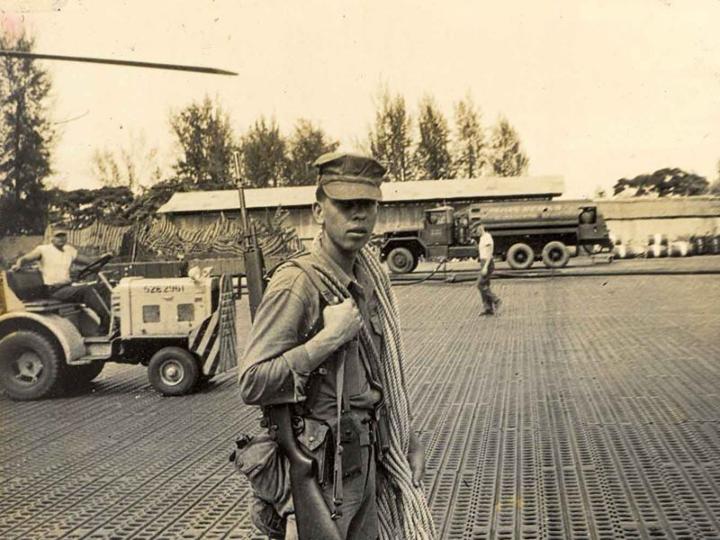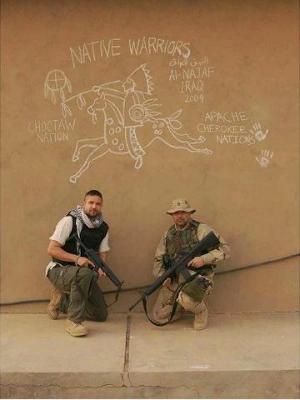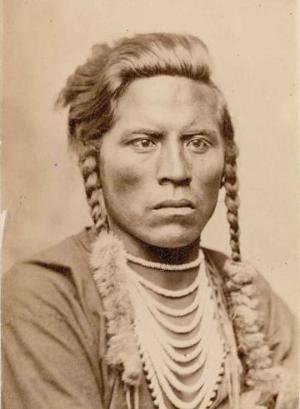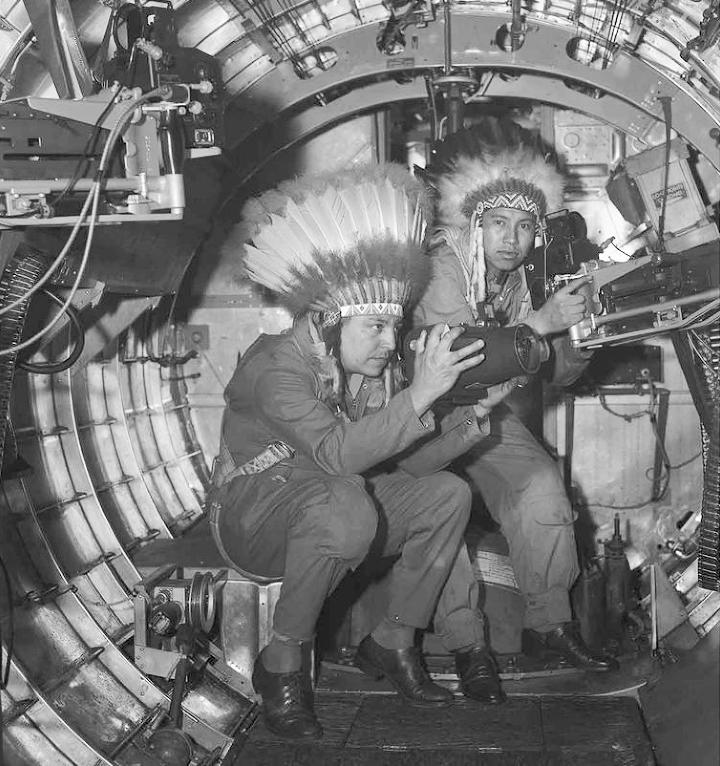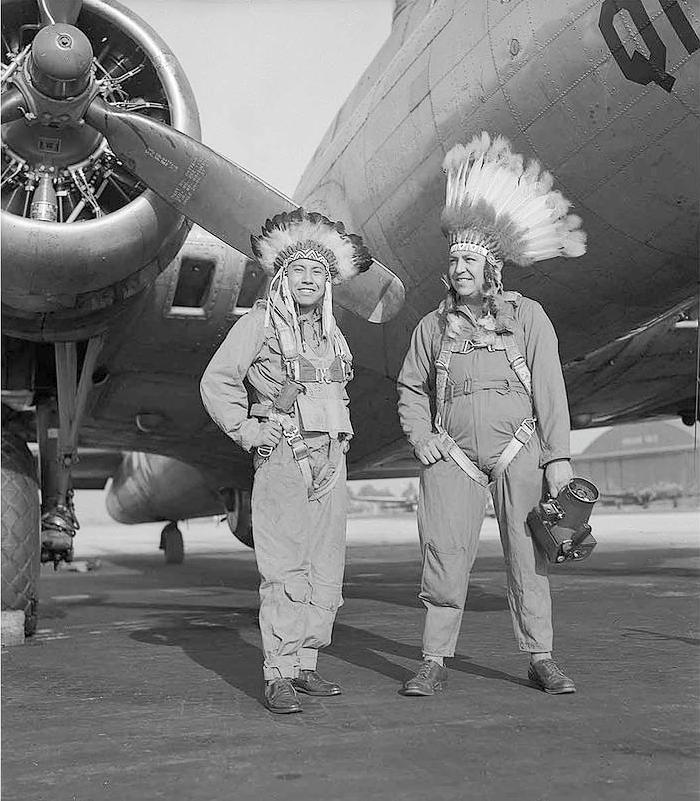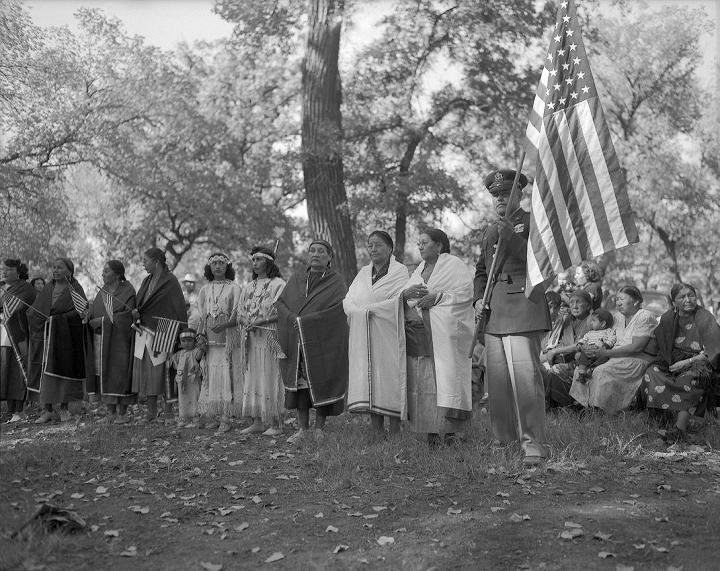 |
Canku Ota
|
 |
|
(Many Paths)
|
||
|
An Online Newsletter
Celebrating Native America
|
||
|
NovemBER 2020 - Volume
18 Number 11
|
||
|
|
||
|
The Remarkable And
Complex Legacy Of Native American Military Service
|
||
|
by Alicia Ault - SMITHSONIANMAG.COM
|
||
|
Why do they serve?
The answer is grounded in honor and love for their homeland
What has compelled so many thousands of American Indians, Alaskan Natives and Native Hawaiians to serve in the U.S. military? It's a question the Smithsonian's National Museum of the American Indian aims to answer with a new book and exhibition devoted to the subject, launching today, November 11, Veteran's Day. Much of what they document in Why We Serve, Native Americans in the United States Armed Forces—a 240-page book that synthesizes established and novel scholarship—may come as a surprise to non-Natives. "The history of Native American service has always been viewed in a reductionist way by the military and by non-Native American society," write authors Alexandra Harris and Mark Hirsch, senior editor and historian, respectively, at the museum. Natives Americans are 'great warriors.' And yet, "not every tribe had a so-called warrior tradition," they write, "many have had distinctly pacific practices, and most balanced warfare with traditions of diplomacy and peace." Native service presents a paradox to non-Natives. Why would they fight for America, which has a long history of colonizing, massacring and breaking treaty promises? It is a fraught history, Hirsch says. "Given that history, why is it that we have this remarkable legacy of Native American military service," he adds. The museum's director Kevin Gover (Pawnee) says that Natives seem to spend little time contemplating this paradox. But in retrospect, they will say "this land is still ours." "They are acknowledging the mistreatment their tribes have suffered at the hands of the United States, yet they still imagine a different and better tribal life in the future," says Gover. They are optimistic that the U.S. will honor sovereignty, which may be why so many cultural celebrations incorporate the American flag, he says. "This is a deep patriotism, a belief that, despite all that has happened, the United States can be better, and we want to be part of that," says Gover. It has been a long-held view that Native Americans have served at a higher rate in proportion to their population than any other racial or ethnic group. Harris says that can't be proven true or false, in part because the U.S. military itself does not keep accurate tallies. "Demographic data about the ethnicity of American servicemen and women has historically been imprecise, and the number of Native Americans who served in the military are, for the most part, estimates," according to Harris. Yet Native Americans—a group that includes American Indians, Alaska Natives and Native Hawaiians—have served in U.S. conflicts since colonial times. Tales of individual soldiers and units have long been known to historians, the military and families. Harris says "ethnicity in the military has always been muddy." Native people in the South were often lumped in with "colored" units. And, when the Selective Service Act was passed in 1917, which led to the draft, it was unclear to the military how to handle enlistment of American Indians who were not U.S. citizens—about a third of the Indian population at the time.
During the Vietnam War, for example, the military did not use the ethnic category "American Indian." Recruiters often used other descriptions, including "Mongolian," "Negro," "Latin" or "Spanish," with some Native Americans also being described as "Caucasian." But Harris and Hirsch, who worked to tease out historical ethnic data from the U.S. Defense Department and other sources, estimate that 1.4 percent of all troops in Vietnam were American Indians, at a time when they represented 0.6 percent of the U.S. population. The scholars estimate that up to a quarter of adult American Indian men served in World War I. During World War II, 44,000 served, with another 800 American Indian women working in various capacities. Some 10,000 served in Korea and approximately 42,000 in Vietnam. Currently, American Indian and Alaska Natives are lumped into a single choice for military personnel who choose to identify an ethnicity. If they choose more than one, they are counted as "other" or "multi-racial." As hard as the military makes it to determine who is serving, it still appears that at least 20,000 American Indians and Alaska Natives are serving, according to the latest data, and that Pacific Islanders serve at the highest rate, around three percent of their population. The lack of solid numbers should not "obscure the bigger picture that Native Americans have demonstrated—and continue to demonstrate—an abiding devotion to military service," writes Harris.
Debunking the Warrior Myth As in other communities, military service is viewed as an honorable tradition by many Native families and tribes. And Native people join for the same reasons as anyone else, say Harris and Hirsch, "to learn a trade, get an education, experience the thrill of piloting a jet, explore new life horizons, strike a blow for gender equality." It's also a way out of desperate poverty. The history of service for many Indigenous people is tied to their love of homeland—which, after all, was theirs long before colonists ever appeared. Some Natives also believe it is their duty to defend America as a manifestation of fulfilling treaty obligations. For Native Hawaiians, military service fits into the traditional concept of aloha—which includes mutual support and mutual cooperation, Staff Sergeant Thomas Kaulukukui told Harris. His father and 11 siblings served during World War II, and he was drafted to fight in Vietnam. "We must serve when needed," Kaulukukui says. A Vietnam veteran said that even though the U.S. had broken its treaty promises, "we are more honorable than that. [We] honor our commitments, always have and always will." And while warrior traditions play a role, it is not, for many Indigenous peoples, the primary reason for military service. "Native people as a whole have been stereotyped throughout history," Harris says. They are typically viewed as having innate warrior skills. "It seems on the surface that this would be a positive stereotype,"—something that wouldn't necessarily be harmful, she says. "But the idea that Native people have some inborn talent at tracking, scouting, martial skills emerges as the military placing them in the most dangerous roles," she says. That has included having them act as point—making them the first people to engage with the enemy. Some tribes—such as the Kiowa and other Great Plains tribes—have a warrior tradition. But "not all tribes do," says Harris. "Some tribes have pacifist traditions that they still adhere to today," she says. Traditions most often are about a balance between war and peace. "Even for those tribes that had warrior traditions there were these countervailing, very, very strong traditions of peace and diplomacy," says Hirsch. Why We Serve seeks to challenge stereotypes and highlight the unique traditions that Indigenous people bring to their military service, such as protection and healing ceremonies, and cleansing after a return from battle. The Warrior Paradox Still, for some Native Americans, joining the U.S. military gave them an opportunity to continue a warrior tradition, especially during the Civil War and the late 19th century, when the U.S. government was bent on assimilating or exterminating American Indians. Native Americans were enlisted—and given military pay—as scouts to help find tribes that were doing their best to defend themselves against encroaching settlers. The U.S. Army believed that having scouts from the same or related tribe would destroy morale and facilitate surrender. Sometimes Indians worked as a type of hired contractor. "They were eager to wage war against a common enemy," say Hirsch and Harris. Whites were powerful allies. In 1876, Crow and Shoshone men went to battle with U.S. General George Crook against the Sioux—a traditional enemy. Osage led U.S. military expeditions against the Comanche and Kiowa. Thus, serving as a scout was a means for continuing a way of life when the U.S. government was trying to stamp out their traditions, says Hirsch. But some may also have viewed their service as a tactic for preventing the Army from wiping out their people. Two scouts may have convinced Geronimo, their fellow Chiricahua Apache, to surrender in 1886. These scouts believed that if Geronimo stayed on the run, periodically raiding, that it would lead to the end of their people, says Hirsch. "I don't think they were trying to sell out their own people—I think they were trying to save them," he says. Unfortunately, but not surprisingly, after the surrender, the U.S. government forcibly removed the Chiricahua to internment camps in Florida and Alabama. The federal government outlawed Native American traditions as part of its assimilationist push. But military service afforded Indigenous people a way to covertly or even overtly get back to some of those practices. The large number of Native people serving during World War II lead to a resurgence of tribal practices—such as protection ceremonies, prayer vigils and carrying of tribal medicine into battle. The Lakota from the Standing Rock Reservation held the first Sun Dance in 52 years, to pray for the destruction of German and Japanese soldiers and the safe return of 2,000 of their soldiers. Research suggests that Native Vietnam veterans may have better coped with anger, depression and post-traumatic stress thanks to "tribal rituals connected with warfare and/or ceremonies of healing." Going away and coming home ceremonies are still practiced, including honoring ceremonies and victory dances, say Harris and Hirsch. For Native Hawaiians traditions that can include hula, surfing, art and songs to commemorate various battles can help with healing and restoration. Powwow celebrations, social dances and other veterans' events—held year-round in Indian Country and in cities and towns across the nation—broaden the support. But, as minorities, Indigenous peoples have unique struggles. "We wear the badge of our service proudly, and our veterans suffer the burdens of war with disproportionate rates of homelessness, behavioral health struggles and lack of access to health services," writes New Mexico congresswoman Deb A. Haaland, an enrolled member of Laguna Pueblo, in the book. Her father was in the Marines in and her mother was in the Navy. The National Native American Veterans Memorial, located on the grounds of the American Indian Museum and opening on November 11, also aims to be a place where Native peoples can honor their traditions and come to pray and heal.
A Book and Exhibition Share Powerful Stories The book Why We Serve, along with its companion exhibition, is primarily about stories, says Hirsch. Master Sergeant Woodrow Wilson Keeble (Dakota Sioux), who served in both World War II—notably at Guadalcanal in the South Pacific—and Korea, was awarded the Distinguished Service Cross, the Purple Heart, the Bronze Star, and in 2008, 26 years after he died, the Medal of Honor. In Korea, Keeble launched a one-man assault against a line of Chinese-held bunkers manned by machine gunners. Armed with an automatic rifle and a bunch of hand grenades, Keeble destroyed all the bunkers on his own, paving the way for his unit to seize the hill. Keeble later became disabled by his war wounds—including from 83 grenade fragments that had to be removed after that assault. But he was still active in veterans' events and causes. The Alaska Territorial Guard (ATG), a band of some 6,300 Natives, ranging in age from 12 to 80, served as the military's eyes and ears along the 6,640 miles of the territory's coastline during World War II. Alaska was highly segregated at the time and Natives were paid less than half of what whites made for the same work. That led to concerns that they might not be the most reliable allies. "As it turned out, there was nothing to worry about; Alaska Natives were eager to serve," writes Paul Ongtooguk (Iñupiaq), director of Alaska Native studies at the University of Alaska, whose father and grandfather served in the Guard. The ATG shot down Japanese balloon bombs that were traveling on the jet stream—that role and those weapons were classified until long after the war. The existence of the Guard also laid the groundwork for racial equality, says Ongtooguk.
Why We Serve is chock full of profiles—from the story of William Pollock, a Pawnee who enlisted and became a vaunted member of Theodore Roosevelt's Rough Riders in Cuba during the Spanish American War to Lori Ann Piestewa, a Hopi citizen who was ambushed and taken prisoner in Iraq in 2003 and died in an Iraqi hospital. Since her death, a signature mountain in Arizona close to her hometown of Tuba City was renamed Piestewa Peak. The U.S. Army has named its Fort Benning, Georgia Directorate of Training Sustainment headquarters Piestewa Hall. "Those personal stories are some of the most important that we can tell," says Harris, noting that "there's no way one book can represent all Native American experience in the U.S. military." Hirsch says he hopes the book inspires further dives into Native veteran service and reflection by those who have served. "Not a lot of people have thought about why they did this," he says. "I'd like to know if the book encourages those veterans to think about their own service as individuals, but also for others to think more deeply about the service of Native American people over the past 243 years of American history." "Why We Serve: Native Americans in the United States Armed Forces" is on view at the Smithsonian's National Museum of the American Indian in the Potomac and available online. The museum is open, but visitors must obtain free timed-entry passes in advance.
Alicia Ault is a Washington, DC-based journalist whose work has appeared in publications including the New York Times, the Washington Post and Wired. When not chasing down a story from our nation's capital, she takes in the food, music and culture of southwest Louisiana from the peaceful perch of her part-time New Orleans home. |
||||||||||||||||||||||||||||
|
|
|
|
||
|
|
||
| Canku Ota is a free Newsletter celebrating Native America, its traditions and accomplishments . We do not provide subscriber or visitor names to anyone. Some articles presented in Canku Ota may contain copyright material. We have received appropriate permissions for republishing any articles. Material appearing here is distributed without profit or monetary gain to those who have expressed an interest. This is in accordance with Title 17 U.S.C. Section 107. | ||
|
Canku Ota is a copyright ©
2000 - 2020 of Vicki Williams Barry and Paul Barry.
|
||
 |
 |
|
|
The "Canku
Ota - A Newsletter Celebrating Native America" web site and
its design is the
|
||
|
Copyright ©
1999 - 2020 of Paul C. Barry.
|
||
|
All Rights Reserved.
|
||
